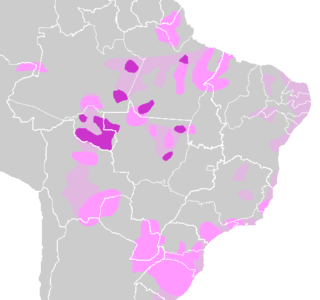Top Qs
Timeline
Chat
Perspective
Tupian languages
Indigenous language family in South America From Wikipedia, the free encyclopedia
Remove ads
The Tupi or Tupian language family comprises some 70 languages spoken in South America, of which the best known are Tupi proper and Guarani.
Remove ads
Homeland and urheimat
Rodrigues (2007) considers the Proto-Tupian urheimat to be somewhere between the Guaporé and Aripuanã rivers, in the Madeira River basin.[1] Much of this area corresponds to the modern-day state of Rondônia, Brazil. Five of the ten Tupian branches are found in this area, as well as some Tupi–Guarani languages (especially Kawahíb), making it the probable urheimat of these languages and maybe of its speaking peoples. Rodrigues believes the Proto-Tupian language dates back to around 3,000 BC.
Remove ads
Language contact
Tupian languages have extensively influenced many language families in South America. Jolkesky (2016) notes that there are lexical similarities with the Arawa, Bora-Muinane, Guato, Irantxe, Jivaro, Karib, Kayuvava, Mura-Matanawi, Taruma, Trumai, Yanomami, Harakmbet, Katukina-Katawixi, Arawak, Bororo, Karaja, Macro-Mataguayo-Guaykuru, Takana, Nadahup, and Puinave-Kak language families due to contact.[2]
Remove ads
History, members and classification
Summarize
Perspective
When the Portuguese arrived in Brazil, they found that wherever they went along the vast coast of South America, most of the indigenous peoples spoke similar languages. Jesuit missionaries took advantage of these similarities, systematizing common standards then named línguas gerais ("general languages"), which were spoken in that region until the 19th century. The best known and most widely spoken of these languages was Old Tupi, a modern descendant of which is still used today by indigenous peoples around the Rio Negro region, where it is known as Nheengatu ([ɲɛʔẽŋaˈtu]), or the "good language". However, the Tupi family also comprises other languages.
In the neighbouring Spanish colonies, Guarani, another Tupian language closely related to Old Tupi, had a similar history, but managed to resist the spread of Spanish more successfully than Tupi resisted Portuguese. Today, Guarani has seven million speakers, and is one of the official languages of Paraguay. The Tupian family also includes several other languages with fewer speakers. These share irregular morphology with the Je and Carib families, and Rodrigues connects them all as a Je–Tupi–Carib family.[3]
Rodrigues & Cabral (2012)
Rodrigues & Cabral (2012) list ten branches of Tupian, which cluster into Western Tupian and Eastern Tupian.[1] Within Western and Eastern Tupian, the most divergent branches are listed first, followed by the core branches.
Meira and Drude (2015) posit a branch uniting Mawé and Aweti with Tupi-Guarani, also known as Maweti-Guarani.[4] Purubora may form a branch together with Ramarama.
Jolkesky (2016)
Internal classification by Jolkesky (2016):[2]
(† = extinct)
- Tupi family
- Arikem
- Monde
- Ramarama-Purubora
- Tupari
- Makurap
- Tupari, Nuclear
- Sakurabiat-Akuntsu
- Kepkiriwat †
- Tupari
- Wayoro
- Tupi, Nuclear
- Juruna
- Munduruku
- Mawe-Aweti-Tupi-Guarani
- Satere-Mawe
- Aweti-Tupi-Guarani
- Aweti
- Tupi-Guarani (see)
Galucio et al. (2015)
Galucio et al. (2015) give the following phylogenetic tree of Tupian, based on a computational phylogenetic analysis.[5]
Remove ads
Vocabulary
Summarize
Perspective
Loukotka (1968) lists the following basic vocabulary items.[6]
Remove ads
See also
References
Further reading
External links
Wikiwand - on
Seamless Wikipedia browsing. On steroids.
Remove ads

